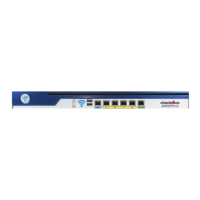25
Signal Strength, Power Levels & Antennas
Communication between your guest’s devices and the CheckBox is a two-way transaction,
not a one-way transaction like a radio or TV broadcast is. For a successful connection not
only does a signal need to get from the CheckBox to the user’s device, but they need to get
a signal back to the CheckBox. Portable WiFi devices are not all created equal and few
have an external antenna. It is not unusual for a guest to “see” a signal of a few bars, or
“good” but have a difficult time maintaining a connection. This is usually a case of the WiFi
device seeing the signal from the CheckBox but the WiFi device does not have the strength
to call back to the CheckBox.
Speaking of signals - signal strength displays are an approximation of the signal strength
averaged over a period of time and do not take into account signal noise, the interference
inherit in every radio transmission. Users may see a strong signal displayed, but due to
noise and interference still not be able to establish a connection. The opposite can also
occur; sometimes users will see a weak signal and still have a solid connection.
Regardless of what the signal strength display reads the bottom line for the user is always
this: Can they connect and is the connection fast enough?
One way to improve the range of the signal is by adding a long range antenna to your
access point (the access point in this case is the CheckBox system). Long range antennas
can sometimes help and sometimes can make the situation worse. While a standard
antenna sends out radio waves equally in all directions like a balloon, long range antennas
achieve greater range by changing the shape of the signal, flattening out the balloon into
more of a donut, sending less of the signal straight up into the sky and more out towards
the edges. These antennas can generally extend the usable range from 10% to 30%.
However they can introduce two new problems; the case of the WiFi device seeing the
CheckBox but the CheckBox not being able to WiFi device mentioned above, or a case
where the “donut” is so flat that it shoots over the heads of the users.
A second type of antenna re-shapes the signal even more, sending it in a pinpoint beam.
These antennas can increase range ten-fold or more, however if the user is not in the
direct path of the signal they will not be able to see it. Even if they are in the direct path if
they are usually not able to send a signal back the full distance and they will not be able to
establish a connection. These high-gain point-to-point antennas are best used in pairs, one
on each end of the path, and while not practical for guest WiFi devices they are good for
connecting buildings in remote locations or repeaters in areas not contiguous to other units.
Another way to improve range is to increase transmit power. Since we do not have control
over the quality of the user’s devices we cannot affect their transmit power, but we could
boost ours. CheckBox already uses the maximum legal power for unlicensed operation in
the frequencies (channels) it occupies. There are WiFi “amplifiers” that can boost power,
but these are not legal. Unlicensed operation at higher power can result in the property
owner being fined.
When you boost the transmit power on one end of the connection but not the other you
also run into the problem of one side being able to see the signal from the other side but
not being able to send a signal back.
Since consumer WiFi devices do not have good antennas and do not generally use the
maximum output power they really benefit from having a high density signal. The best way
to have a high density signal is by using multiple access points.
Determining the proper number of access points requires taking into consideration several
factors:
How much area do you need to cover? What are the surroundings? Are there walls or open
spaces? Is the building made of wood, rebar reinforced concrete, or steel? Is there any

